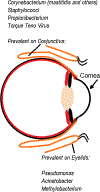Visions of Eye Commensals: The Known and the Unknown About How the Microbiome Affects Eye Disease
- PMID: 30289987
- PMCID: PMC6354774
- DOI: 10.1002/bies.201800046
Visions of Eye Commensals: The Known and the Unknown About How the Microbiome Affects Eye Disease
Abstract
Until recently, the ocular surface is thought by many to be sterile and devoid of living microbes. It is now becoming clear that this may not be the case. Recent and sophisticated PCR analyses have shown that microbial DNA-based "signatures" are present within various ethnic, geographic, and contact lens wearing communities. Furthermore, using a mouse model of ocular surface disease, we have shown that the microbe, Corynebacterium mastitidis (C. mast), can stably colonize the ocular mucosa and that a causal relationship exists between ocular C. mast colonization and beneficial local immunity. While this constitutes proof-of-concept that a bona fide ocular microbiome that tunes immunity can exist at the ocular surface, there remain numerous unanswered questions to be addressed before microbiome-modulating therapies may be successfully developed. Here, the authors will briefly outline what is currently known about the local ocular microbiome as well as microbiomes associated with other sites, and how those sites may play a role in ocular surface immunity. Understanding how commensal microbes affect the ocular surface immune homeostasis has the potential revolutionize how we think about treating ocular surface disease.
Keywords: immunity; ocular disease; ocular microbiome.
Published 2018, WILEY-VCH Verlag GmbH & Co. KGaA, Weinheim. This article is a U.S. Government work and is in the public domain in the USA.
Conflict of interest statement
Conflict of Interest
The authors declare no conflict of interest.
Figures
Similar articles
-
Ocular Microbiota and Intraocular Inflammation.Front Immunol. 2020 Dec 23;11:609765. doi: 10.3389/fimmu.2020.609765. eCollection 2020. Front Immunol. 2020. PMID: 33424865 Free PMC article.
-
Genetic Manipulation of Corynebacterium mastitidis to Better Understand the Ocular Microbiome.Invest Ophthalmol Vis Sci. 2023 Feb 1;64(2):19. doi: 10.1167/iovs.64.2.19. Invest Ophthalmol Vis Sci. 2023. PMID: 36799874 Free PMC article.
-
An Ocular Commensal Protects against Corneal Infection by Driving an Interleukin-17 Response from Mucosal γδ T Cells.Immunity. 2017 Jul 18;47(1):148-158.e5. doi: 10.1016/j.immuni.2017.06.014. Epub 2017 Jul 11. Immunity. 2017. PMID: 28709803 Free PMC article.
-
Perturbations of the ocular surface microbiome and their effect on host immune function.Curr Opin Ophthalmol. 2023 Mar 1;34(2):181-188. doi: 10.1097/ICU.0000000000000931. Epub 2022 Dec 22. Curr Opin Ophthalmol. 2023. PMID: 36728960 Free PMC article. Review.
-
Changes in the Eye Microbiota Associated with Contact Lens Wearing.mBio. 2016 Mar 22;7(2):e00198. doi: 10.1128/mBio.00198-16. mBio. 2016. PMID: 27006462 Free PMC article.
Cited by
-
Trends and Treatment Approaches for Complications in Neuroscience Experiments with Monkey Species.Comp Med. 2023 Jun 1;73(3):216-228. doi: 10.30802/AALAS-CM-22-000079. Epub 2023 May 19. Comp Med. 2023. PMID: 37208151 Free PMC article.
-
Exploring the Ocular Surface Microbiome and Tear Proteome in Glaucoma.Int J Mol Sci. 2024 Jun 6;25(11):6257. doi: 10.3390/ijms25116257. Int J Mol Sci. 2024. PMID: 38892444 Free PMC article.
-
Association between gut microbiota and diabetic microvascular complications: a two-sample Mendelian randomization study.Front Endocrinol (Lausanne). 2024 Aug 2;15:1364280. doi: 10.3389/fendo.2024.1364280. eCollection 2024. Front Endocrinol (Lausanne). 2024. PMID: 39157683 Free PMC article.
-
Current Evidence for Corynebacterium on the Ocular Surface.Microorganisms. 2021 Jan 27;9(2):254. doi: 10.3390/microorganisms9020254. Microorganisms. 2021. PMID: 33513871 Free PMC article. Review.
-
Chloramphenicol Resurrected: A Journey from Antibiotic Resistance in Eye Infections to Biofilm and Ocular Microbiota.Microorganisms. 2019 Aug 21;7(9):278. doi: 10.3390/microorganisms7090278. Microorganisms. 2019. PMID: 31438629 Free PMC article. Review.
References
-
- Rabot S, Membrez M, Bruneau A, Gerard P, Harach T, Moser M , Raymond F, Mansourian R, Chou CJ, FASEB J 2010, 24, 4948. - PubMed
-
- Nell S, Suerbaum S, Josenhans C, Nat. Rev. Microbiol 2010, 8, 564. - PubMed
-
- Markle JG, Frank DN, Mortin-Toth S, Robertson CE, Feazel LM, Rolle-Kampczyk U, von Bergen M, McCoy KD, Macpherson AJ, Danska JS, Science 2013, 339, 1084. - PubMed


